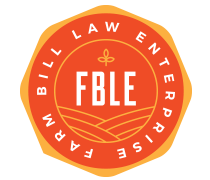Josie Dudzik is a PhD candidate in Nutrition and Dietetics at New York University and is a guest contributor to this blog. She was an intern in the Harvard Law School Food Law and Policy Clinic during the summer of 2024.
Background
The 2018 Farm Bill paved the way for domestic hemp production by reclassifying hemp as legal to grow in the United States (US) with federal oversight. Under the Domestic Hemp Production Program, States and Indian Tribes can submit plans for the domestic production of hemp for approval by the United States Department of Agriculture (USDA), which regulates hemp production in addition to administering farm programs that may benefit hemp producers. Producers must also maintain reports on land use, cannabinol levels in crops, methods of disposal, licensure, and compliance with regulations set forth by the Domestic Hemp Production Program.
USDA Farm Programs for Hemp Producers in the 2018 Farm Bill
The USDA oversees numerous programs made available to hemp farmers in the US by the 2018 Farm Bill. Starting in the 2020 crop year, hemp producers are eligible for several crop insurance plans, the Noninsured Crop Disaster Assistance Program, Farm Service Agency farm loans, and Natural Resources Conservation Service conservation programs. Such programs aim to expand the domestic hemp production industry and provide new economic opportunities to hemp farmers.
Hemp Provisions in the House 2024 Farm Bill
In May 2024, the House Committee on Agriculture approved the House of Representatives version of the 2024 Farm Bill. The House 2024 Farm Bill amends language in the 2018 Farm Bill that resulted in the unintended legalization of certain hemp-derived cannabinoids, a $28.4 billion market that produces products meeting the definition of hemp, and are therefore not considered a controlled substance.
This language, known as the Miller Amendment given its introduction by U.S. Representative Mary Miller (R-IL-15), reclassifies the legal limit for hemp previously based on its delta-9-tetrahydrocannabinol (delta-9 THC) concentration instead based on its total tetrahydrocannabinol (total THC) concentration. This revision would make certain hemp-derived cannabinoid products illegal, including those containing higher levels of non-regulated THC derivatives, such as delta-8-tetrahydrocannabinol (delta-8 THC) which has similar psychoactive effects as delta-9 THC. Additionally, the House 2024 Farm Bill amends the definition of hemp as containing only naturally occurring, naturally derived and nonintoxicating cannabinoids, and prohibits hemp cannabinoid products or any other cannabinoids with quantifiable amounts of total THC. Per industry stakeholders, this language would largely restrict the production of hemp for hemp-derived cannabinoid products, including many of the widely popularized cannabidiol (CBD) products which would now require determinations by the USDA to ensure no quantifiable amount of neither total THC or alternative having “similar effects on humans or animals” as THC are present. All synthetic compounds that do not occur naturally in the Cannabis sativa L. plant are also excluded from the legal definition of hemp as per the Drug Enforcement Administration ruling, making them illegal at the federal level
Future Directions for the Hemp Industry
Despite the proposed redefinition of hemp, opportunities for industry advancement and advocacy remain. Numerous stakeholders in the hemp industry have opposed the language in the House 2024 Farm Bill, including the American Trade Association for Cannabis and Hemp, U.S. Hemp Roundtable, and Indigenous Cannabis Industry Association. This agreement amongst industry stakeholders provides the opportunity for coordination and collaboration as a joint effort to advocate against the Miller Amendment in the House 2024 Farm Bill. As the Senate is yet to release their version of the 2024 Farm Bill, stakeholders should direct advocacy efforts to their state’s Senators to both modify the language reclassifying hemp as well as directing more research and program funding to the hemp industry.
In 2022, the USDA in collaboration with Oregon State University’s Global Hemp Innovation Center held a National Hemp Industry Research Needs Workshop, resulting in the development of the Hemp Research Needs Roadmap. This document outlines 4 key needs areas of hemp research along with potential roles for the public and private sectors, which are as follows: 1) Breeding and genetics; 2) Best practices for production; 3) Biobased products manufacturing for end-uses; and 4) Transparency and consistency. Hemp farmers and industry stakeholders can use this roadmap to support their advocacy for directed funding in the 2024 Farm Bill. Additionally, this roadmap can be used as leverage for future funding opportunities outside of the Farm Bill in any of the USDA’s priority research areas.
The views and opinions expressed on the FBLE Blog are those of the authors and do not necessarily reflect the official policy or position of FBLE. While we review posts for accuracy, we cannot guarantee the reliability and completeness of any legal analysis presented; posts on this Blog do not constitute legal advice. If you discover an error, please reach out to contact@farmbilllaw.org.

